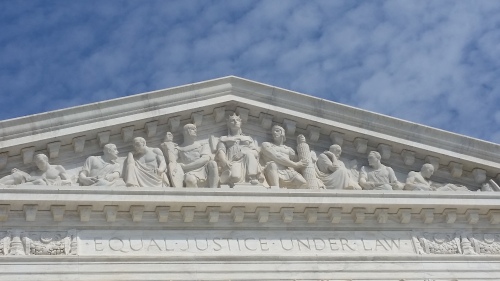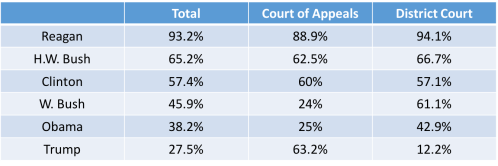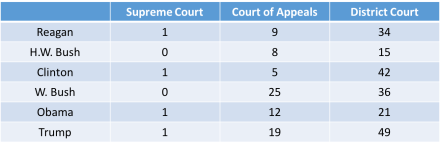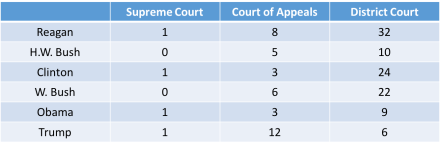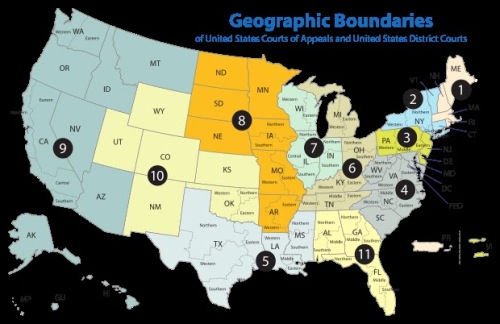
Judge Amul Roger Thapar has broken many barriers in his life. He was the first Indian American to serve as U.S. Attorney for a federal district, the first Indian American to serve as an Article III federal judge, and finally, the first nominee to a lower court vacancy by the Trump Administration. For each of these steps, Thapar has one man to thank, Senate Majority Leader Mitch McConnell (R-KY), who has carefully steered his protege’s career. Nevertheless, setting aside McConnell’s influence, Thapar’s conservative record and relative youth make him an ideal candidate for a judgeship under a Republican Administration.
Background
Amul Roger Thapar was born to a family of Indian immigrants in Detroit, Michigan on Apr. 29, 1969. Thapar attended Boston College and UC Berkeley School of Law, receiving his J.D. in 1994. After graduating, Thapar clerked for Judge J. Arthur Spiegel on the Southern District of Ohio and Sixth Circuit Judge Nathaniel Jones. After a short stint as an associate at Williams and Connolly, Thapar joined the U.S. Attorney’s Office in Washington D.C.
In 2002, Thapar joined the U.S. Attorney’s Office in the Southern District of Ohio. During this time, Thapar volunteered for the campaigns of several Kentucky Republicans, including Gov. Ernie Fletcher, Sen. Jim Bunning, Secretary of State Trey Grayson, and Congressman Geoff Davis, as well as the re-election campaign of President George W. Bush.
Despite having no previous work experience in Kentucky, Thapar was handpicked by McConnell to serve as the U.S. Attorney for the Eastern District of Kentucky in 2006, replacing Gregory Van Tatenhove, who had been confirmed to a federal judgeship. As the chief federal prosecutor in Eastern Kentucky, Thapar supervised all civil and criminal litigation in the district.
In May 2007, only a year after becoming the U.S. Attorney, the then 38-year-old Thapar was nominated for a federal district court seat vacated by Judge Joseph Hood. The Democratic controlled Senate Judiciary Committee gave Thapar a hearing on Oct. 24, 2007.[1] The Committee unanimously approved Thapar’s nomination on Nov. 15, 2007.[2] Thapar was then unanimously confirmed by the Senate on Dec. 13, 2007, making him the then youngest Article III judge in the country.[3]
History of the Seat
Thapar has been nominated for a Kentucky seat on the U.S. Court of Appeals for the Sixth Circuit. This seat opened four years ago with the retirement of Judge Boyce Martin, a fierce liberal voice on the circuit.[4] Martin’s retirement in 2013 gave then-President Barack Obama the first opportunity to fill the seat. However, the Senate’s blue slip process allowed McConnell and Sen. Rand Paul (R-KY) veto power over Obama’s choices. After negotiating with McConnell for two years, Obama nominated Kentucky Supreme Court Justice Lisabeth Tabor Hughes for the seat.[5] Hughes, who would have been the first female judge from Kentucky on the Sixth Circuit, was blocked by McConnell, who argued that he was not consulted on the choice.[6] Other observers believed, however, that McConnell was leaving the seat open for the candidate he wanted to fill the position: Thapar.[7]
Without McConnell’s support, Hughes’ nomination never received a hearing in the Republican-controlled Senate, and was returned at the end of the Obama Administration. Less than two months later, Thapar was nominated for the seat.
Jurisprudence
In his nine years on the federal bench, Thapar has authored more than 600 orders and opinions. These opinions are frequently peppered with colloquialisms, aphorisms, and other forms of folksy language.[8] While Thapar’s record generally indicates a conservative judicial philosophy, there are some notable characteristics that suggest a more independent bent.
Willingness to Let Civil Cases Reach the Jury
A trial judge is supposed to grant summary judgment when there is no substantial dispute of facts between the parties for a jury to resolve. In some cases, judges grant summary judgment to dismiss cases even where substantial factual disputes remain.[9] While Thapar has granted summary judgement to defendants in many cases,[10] his overall record indicates a willingness to allow juries to resolve factual disputes.[11]
For example, in one case, Thapar noted:
“In baseball, ties go to the runner. In summary judgment, ties go to the plaintiff. Why? Because civil litigants have a right to a jury trial. And when a case comes down to a close call, the jury must be the one to make it.”[12]
Similarly, Thapar noted in another case:
“Courts are ill-equipped to resolve disputes between experts about critical facts, and at the summary judgment stage, courts are not authorized to do so. So it should come as no surprise that the heavily factual dispute between the parties here must proceed to trial.”[13]
In yet another case, where the plaintiff sued Walmart for failure to adequately clear a spill, Thapar denied Walmart’s motion for summary judgement, arguing that a jury should decide if Walmart had sufficient time to notice and clean the spill.[14]
Mixed Record on Criminal Procedural Protections
As a former prosecutor, one would expect Thapar to take a narrow view of Fourth, Fifth, and Sixth Amendment protections. While there are a handful of cases in which Thapar has granted suppression motions based on violations of procedural rights, his overall jurisprudence generally sides against defendants.
For example, Thapar has repeatedly upheld searches and seizures from Fourth Amendment challenges.[15] In U.S. v. Frechette, while sitting by designation on the Sixth Circuit, Thapar held that the purchase of a one-month subscription to a child pornography site provided “probable cause” for a search warrant.[16] Thapar’s opinion sparked a fierce dissent by Judge Karen Nelson Moore, who noted that Thapar’s “radical view of probable cause” was “far more expansive than any circuit had taken to date.”[17]
In another case, Thapar held that officers did not violate the Fourth Amendment where they took the suspect to a hospital to undergo a digital rectal exam.[18] Specifically, Thapar relied on the fact that officers reasonably believed that the medical exam was necessary to the suspect, and that they did not ask for the rectal exam.[19]
However, in a few cases, Thapar has sided with defendants against law enforcement or prosecutorial overreach.[20] In one case, Thapar found that DEA agents violated the Fourth Amendment by placing a GPS tracker on a defendant’s car without a warrant.[21] In another, case, Thapar held that law enforcements erroneously relied on a warrant that was not supported by probable cause in searching a defendant’s home, and as such, all items found in the search must be suppressed.[22]
Willingness to Overrule Administrative Rulings on Disability Claims
The Eastern District of Kentucky covers many counties where residents rely on coal mining as the chief source of employment. As a result, the judges of the Eastern District hear many appeals from denials of benefits from the Social Security Administration. In these cases, judges are generally asked to defer to the findings of the Administrative Law Judges (ALJs) below. As such, reversals are rare.
Thapar’s cases generally follow this pattern. In most of the social security appeals he has heard, Thapar has affirmed the decision of the ALJ below.[23] However, in a number of cases, Thapar has reversed the ALJ, ruling that they have failed to support their ruling denying benefits.[24] For example, in one case, Thapar held that the ALJ had failed to adequately support his ruling that the plaintiff was not disabled.[25]
Prominent Reversals
Over his eight year tenure on the Eastern District of Kentucky, approximately fifteen of Thapar’s opinions have been reversed by the Sixth Circuit, or the Supreme Court. Here is a summary of the more prominent reversals.
Reversals by the Sixth Circuit
Hill v. Lappin – This case involved a prisoner, Hill, who brought a Bivens action arguing that he was placed in segregated housing in retaliation for grievances he had filed against prison staff. Thapar dismissed the case, stating that prisoners did not have a constitutional right to avoid prison transfers or segregation.[26] The Sixth Circuit reversed in an opinion by Judge Ronald Gilman.[27] Judge Gilman argued that Hill had successfully pled a First Amendment retaliation claim.[28]
Turner v. Astrue – This case involved an appeal from denial of benefits by an ALJ. While Thapar reversed the denial of benefits, he ruled that the plaintiff was not entitled to attorney’s fees.[29] The Sixth Circuit reversed, holding that the plaintiff had earned attorney’s fees under the Equal Access to Justice Act.[30]
Sours v. Big Sandy Reg’l Jail Auth. – This case involved a suit against a state prison after an inmate died of complications from diabetes. Thapar held that the prison nurse and other officials were entitled to summary judgment.[31] The Sixth Circuit affirmed the grant of summary judgment against most prison officials, but reversed the grant with respect to the nurse.[32]
United States v. Badger – This case involved a $5000 fine imposed on a prisoner by Thapar. To ensure collection of the fine, Thapar ordered the garnishment of funds from the prisoner’s prison account.[33] The Sixth Circuit reversed the garnishment, holding that the law only permitted garnishment when the prisoner was already in default on the fine.[34]
United States v. Walli – This case involved three defendants who were opposed to the proliferation of nuclear weapons. The defendants broke into a nuclear facility, and vandalized it with banners and human blood. Thapar affirmed the defendants’ convictions for willful injury of national defense premises with intent to harm the national defense.[35] The Sixth Circuit reversed in an opinion by Judge Raymond Kethledge, holding that the defendants did not “intend” to harm the national defense.[36]
Winter v. Wolnitzek – This case involved challenges to a number of canons in the Kentucky Code of Judicial Conduct. Thapar struck down the canons, ruling that they violated the First Amendment.[37] On appeal, the Sixth Circuit, in an opinion by Judge Jeffrey Sutton, affirmed most of the rulings, but held that one canon, which prohibited judges from holding political fundraisers, was not unconstitutional.[38]
Summary Reversals by the Supreme Court
Lovell v. Duffey – In this case, Thapar, sitting by designation on the Sixth Circuit, joined a decision by Judge Ronald Gilman rejecting a claim for ineffective assistance of counsel made by a state court prisoner.[39] The Supreme Court summarily reversed the ruling, remanding it for consideration in light of its ruling in Cullen v. Pinholster.[40]
Overall Assessment
Being the first is not always ideal. The first judicial nominee sent by a polarizing President often brings unwarranted scrutiny. Judge David Hamilton, President Obama’s first nominee to the federal bench, was, by all accounts, a moderate, credentialed, and well-liked candidate. He nevertheless faced a well-organized smear campaign smearing him as a radical extremist.
It remains to be seen if Thapar will face a similar campaign. But, looking at his record, there is nothing to suggest that he will be an extremist on the bench. Thapar has made decisions that have been reversed by higher courts, as has virtually every district judge in the country. Nevertheless, there is no pattern in these reversals that suggest that Thapar is ruling based on his personal views. Rather, his record suggests that, while Thapar is conservative, he is nonetheless a judge who takes the law seriously.
Setting aside his demographic fame as the first Indian American to take a Sixth Circuit seat, Thapar is unquestionably qualified for this appointment, and likely would be a credit to the court.
[1] Confirmation Hearings on Federal Appointments Before the S. Comm. on the Judiciary, 110th Cong. Serial No. J-110-15 (2007) (Statement of Sen. Patrick Leahy).
[2] Executive Business Meeting Before the S. Comm. on the Judiciary, 110th Cong. Serial No. J-110-15 (2007) (Statement of Sen. Patrick Leahy).
[3] This record would be broken by the confirmation of Judge Edmond Chang three years later.
[4] Sam Roberts, Boyce F. Martin, Jr., Liberal U.S. Judge in Seminal Cases, Dies at 80, N.Y. Times, Jun 7, 2016, https://www.nytimes.com/2016/06/08/us/boyce-f-martin-jr-liberal-federal-appellate-judge-dies-at-80.html?_r=0.
[5] Press Release, The White House, President Obama Nominates Justice Lisabeth Tabor Hughes to Serve on the United States Court of Appeals (Mar. 17, 2016) (on file with the White House).
[6] Joseph Gerth, McConnell Rejects Obama Choice of Ky. Judge, Louisville Courier Journal, Mar. 18, 2016, http://www.courier-journal.com/story/news/politics/2016/03/18/mcconnell-says-he-kill-6th-circuit-nomination/81971446/ (quoting Robert Steurer, spokesperson for McConnell) (“Rather than work with [McConnell] to fill this vacancy, [the Obama White House] submitted Justice Hughes without even notifying Leader McConnell. He will not support action on this nomination.”).
[7] Id. (“Louisville lawyer Sheryl Snyder said that he believes that McConnell is backing U.S. District Judge Amul Thapar…”).
[8] See, e.g., Nationwide Mut. Fire Ins. Co. v. Nelson, 912 F. Supp. 2d 452, 453 (E.D. Ky. 2012) (“After Nelson’s lie, he quickly learned that Nationwide was no longer on his side.”).
[9] See, e.g., Burgess v. Bowen, 466 F. App’x 272, 284 (4th Cir. 2012) (reversing grant of summary judgment in a case with “an abundance of genuine factual disputes on material issues”).
[10] See, e.g., Collins v. Penske Truck Leasing Corp., No. CV 13-181-ART, 2015 WL 5698536, at *1 (E.D. Ky. Sept. 28, 2015); Mountain Motorsports Paving & Const. LLC v. Yamaha Motor Corp., U.S.A., No. CIV. 14-76-ART, 2014 WL 5341865, at *1 (E.D. Ky. Oct. 20, 2014); Perry v. Corr. Corp. of Am., No. CIV. 11-150-ART, 2012 WL 5289413, at *1 (E.D. Ky. Oct. 23, 2012); Boggs v. 3M Co., No. CIV. 11-57-ART, 2012 WL 3644967, at *1 (E.D. Ky. Aug. 24, 2012), aff’d, 527 F. App’x 415 (6th Cir. 2013).
[11] See, e.g., Worldwide Equip. Enterprises, Inc. v. Broan-Nuton LLC, 191 F. Supp. 3d 684, 691 (E.D. Ky. 2016); City of Pikeville, Kentucky v. Broan-Nutone, LLC, No. CV 15-71-ART, 2016 WL 2843916, at *1 (E.D. Ky. May 10, 2016) (holding that the plaintiff did not need expert evidence to prove damages); Griffith v. Conn, No. CV 11-157-ART-EBA, 2016 WL 1029331, at *1 (E.D. Ky. Mar. 14, 2016); Holder v. Saunders, No. CV 13-38-ART, 2015 WL 6756374, at *1 (E.D. Ky. Nov. 4, 2015); Adler v. Elk Glenn, LLC, No. CIV. 12-85-ART, 2013 WL 6632057, at *1 (E.D. Ky. Dec. 17, 2013); EQT Gathering, LLC v. A Tract of Prop. Situated in Knott Cty., Ky., 970 F. Supp. 2d 655, 657 (E.D. Ky. 2013); Nevels v. Deerbook Ins. Co., No. CIV. 10-83-ART, 2011 WL 3903209, at *1 (E.D. Ky. Sept. 6, 2011); Recycling Sols. Tech., LLC v. Rosenberg, No. CIV.A. 10-55-ART, 2011 WL 1696826, at *1 (E.D. Ky. May 4, 2011); Ziarko v. Crawford Law Offices, PLLC, No. CIV 10-153-ART, 2010 WL 5059569, at *1 (E.D. Ky. Dec. 6, 2010). See also Brown v. Travelers Cas. Ins. Co. of Am., No. 15-50-ART, 2016 WL 1644342, at *4 (E.D. Ky. Apr. 25, 2016) (denying a motion for judgment on the pleadings).
[12] Bentley v. Highlands Hosp. Corp., No. CV 15-97-ART, 2016 WL 7234757, at *1 (E.D. Ky. Dec. 13, 2016) (internal citations omitted).
[13] Am. Towers LLC v. BPI, Inc., No. CIV. 12-139-ART, 2014 WL 3818193, at *1 (E.D. Ky. Aug. 4, 2014).
[14] Stanley v. Walmart Stores E., LP, No. 15-86-ART, 2016 WL 3079837, at *3 (E.D. Ky. May 31, 2016).
[15] See United States v. Herrera, 636 F. App’x 250, 254 (6th Cir. 2016); United States v. Lovell, No. CRIM. 14-25-ART-10, 2014 WL 7069317, at *1 (E.D. Ky. Dec. 12, 2014); United States v. Roos, No. CRIM. 12-09-2-ART, 2013 WL 1136629, at *1 (E.D. Ky. Mar. 18, 2013); United States v. Cunnagin, No. CRIM. 10-31-ART, 2011 WL 4072817, at *1 (E.D. Ky. Sept. 13, 2011); United States v. Marcum, No. CRIM. 10-53-ART, 2011 WL 1115000, at *1 (E.D. Ky. Mar. 25, 2011); United States v. Polly, No. CRIM. 10-25-ART, 2010 WL 3984936, at *1 (E.D. Ky. Oct. 8, 2010); United States v. Pennington, No. CRIM.10-11-ART, 2010 WL 3724841, at *1 (E.D. Ky. Sept. 17, 2010); United States v. Dadanovic, No. CRIM. 09-63-ART, 2010 WL 3620251, at *1 (E.D. Ky. Sept. 10, 2010); U.S. Taylor, No. CRIM. 09-43-ART, 2010 WL 3190740, at *1 (E.D. Ky. Aug. 11, 2010); United States v. Goetting, No. CRIM.09-60(1)&(2)ART, 2010 WL 989035, at *1 (E.D. Ky. Mar. 15, 2010).
[16] United States v. Frechette, 583 F.3d 374, 376 (6th Cir. 2009).
[17] Id. at 381 (Moore, J., dissenting).
[18] United States v. Shepherd, No. CRIM. 13-25-ART-EBA-, 2014 WL 4594565, at *1 (E.D. Ky. Sept. 15, 2014), aff’d, 646 F. App’x 385 (6th Cir. 2016).
[19] Id.
[20] See, e.g., United States v. Sydnor, No. CR 16-21-ART-HAI-(2), 2017 WL 772341, at *6 (E.D. Ky. Feb. 28, 2017) (suppressing non-Mirandized statement as elicited in violation of the Fifth Amendment).
[21] United States v. Lee, 862 F. Supp. 2d 560, 562 (E.D. Ky. 2012).
[22] See United States v. Rice, 704 F. Supp. 2d 667, 668 (E.D. Ky. 2010).
[23] See, e.g., Oaks v. Colvin, No. CV 15-249-ART, 2016 WL 6133859, at *1 (E.D. Ky. Mar. 30, 2016); Eaton v. Colvin, No. CV 15-111-ART, 2015 WL 12683970, at *1 (E.D. Ky. Dec. 23, 2015); Roberts v. Colvin, No. CV 15-164-ART, 2015 WL 12661963, at *1 (E.D. Ky. Dec. 22, 2015); Morgan v. Colvin, No. CV 15-45-ART, 2015 WL 12672119, at *1 (E.D. Ky. Dec. 7, 2015); Rolf v. Colvin, No. CV 14-56-ART, 2014 WL 12567181, at *1 (E.D. Ky. Oct. 24, 2014); Morgan v. Astrue, No. CIV. 12-36-ART, 2012 WL 6623266, at *1 (E.D. Ky. Dec. 19, 2012).
[24] Buchanan v. Colvin, No. CV 13-133-ART, 2014 WL 12649006, at *1 (E.D. Ky. May 12, 2014) (reversing the ALJ for failing to follow the “treating physician” rule); Thomas v. Colvin, No. CIV. 12-157-ART, 2013 WL 2103143, at *1 (E.D. Ky. May 13, 2013); Coleman v. Astrue, No. CIV. 12-172-ART, 2013 WL 173196, at *1 (E.D. Ky. Jan. 16, 2013);
[25] Pike v. Colvin, No. CV 13-154-ART, 2014 WL 12573849, at *1 (E.D. Ky. Feb. 11, 2014).
[26] Hill v. Lappin, No. CIV.A. 09-07-ART, 2009 WL 1036127, at *1 (E.D. Ky. Apr. 17, 2009), rev’d, 630 F.3d 468 (6th Cir. 2010).
[27] Hill v. Lappin, 630 F.3d 468 (6th Cir. 2010).
[28] Id. at 471-72.
[29] Turner v. Astrue, 764 F. Supp. 2d 864, 866 (E.D. Ky. 2010).
[30] Turner v. Comm’r of Soc. Sec., 680 F.3d 721 (6th Cir. 2012).
[31] Sours v. Big Sandy Reg’l Jail Auth., 946 F. Supp. 2d 678, 681 (E.D. Ky. 2013).
[32] Sours v. Big Sandy Reg’l Jail Auth., 593 F. App’x 478 (6th Cir. 2014).
[33] United States v. Badger, No. CRIM. 13-3-ART, 2013 WL 5529329, at *2 (E.D. Ky. Oct. 1, 2013).
[34] United States v. Badger, 581 F. App’x 541 (6th Cir. 2014).
[35] United States v. Walli, 976 F. Supp. 2d 998, 1006–07 (E.D. Tenn. 2013).
[36] United States v. Walli, 785 F.3d 1080 (6th Cir. 2015).
[37] Winter v. Wolnitzek, 56 F. Supp. 3d 884, 889 (E.D. Ky. 2014).
[38] Winter v. Wolnitzek, 834 F.3d 681 (6th Cir. 2016).
[39] Lovell v. Duffey, 629 F.3d 587, 588 (6th Cir. 2011), cert. granted, judgment vacated, 566 U.S. 902, 132 S. Ct. 1790, 182 L. Ed. 2d 613 (2012).
[40] Lovell v. Duffey, 566 U.S. 902, 132 S. Ct. 1790, 182 L. Ed. 2d 613 (2012).
